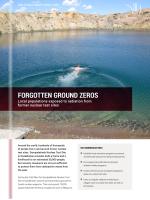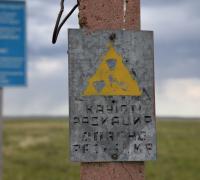Forgotten ground zeros
Around the world, hundreds of thousands of people live in and around former nuclear test sites. Semipalatinsk Nuclear Test Site in Kazakhstan provides both a home and a livelihood for an estimated 50,000 people, but security measures are not yet sufficient to protect them from radioactive waste from the past.
■ Encourage local authorities to promote radiation-safety programs
■ Cordon off and secure unmarked radioactive areas on nuclear test sites
■ Carry out regular radiation monitoring in villages close to nuclear test sites, as well as of livestock
During the Cold War, the Semipalatinsk Nuclear Test Site in Kazakhstan was the primary testing ground for Soviet nuclear weapons. This once-secret 19,000 square-kilometre territory (roughly the size of Belgium),located in the northeast of the country, covers the three Kazakhstani oblasts (provinces) of Pavlodar, Eastern Kazakhstan and Karaganda. Between 1949 and 1989, 456 nuclear tests were carried out at four major testing sites in this area and in a variety of contexts: in the atmosphere, underground and in horizontal tunnels inside a mountain.
Since gaining independence in 1991, Kazakhstan has attracted international praise for closing the site and supporting initiatives to create a nuclear weapons-free zone in Central Asia. However, the region has been inhabited for decades. Although this vast ground zero of the former Soviet Union provides both a home and an economic lifeline for 50,000 people, security measures are not yet sufficient to protect them from radioactive waste from the past. Despite significant progress on matters related to issues of nuclear proliferation, Kazakhstan and international partners, such as the United Nations (UN) and the International Atomic Energy Agency (IAEA), should work together to develop stronger measures to protect people than what we are seeing today.
Miners report being encouraged to drink a prophylactic shot of vodka to guard against radiation exposure.
Nuclear test site today
The Semipalatinsk Nuclear Test Site and its facilities are monitored by the Institute of Radiation Safety and Ecology, which helped to handle the conversion of the territory to non-military uses and now leads ecological work in radiation monitoring. Several mines operate in the region, extracting copper, coal, fluorite, table salt and manganese, among others. Some of these operations are near, or on top of, the main experimental fields that are polluted with residual radioactivity. Excluding secure areas around the Degelen Mountain complex and the Baykal-1 and IGR research reactors, which are guarded by surveillance equipment and dedicated security forces, there is no perimeter fence around the site. In general, the area is accessible to virtually anyone. Only a handful of weathered signs indicate a danger from radiation without giving specific details. Radioisotopes, such as plutonium, strontium and caesium, among others, can be found throughout the area, and highly radioactive areas remain unmarked.
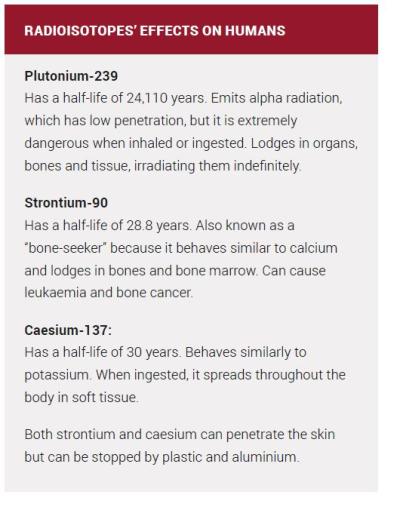
People use the test site in several ways, for example, as a vast pastureland for grazing local herds of goats, sheep, horses and cows from neighbouring villages. Water-filled radioactive craters serve to provide both swimming holes and drinking water for animals. Men and women from the surrounding communities seek employment at mining ventures currently operating within the borders of the test site. Also, people regularly take shortcuts by driving across the territory, especially during the warmer months, to visit relatives in nearby villages or distant cities. Finally, families frequently gather to collect wild strawberries in the test site’s shallow valleys to make jams and juices.
Because efforts to protect unmarked radioactive areas and raise awareness about dangerous pollution remain inadequate, people who regularly venture on to the test site have no way of knowing which areas to avoid. Those who work in the mines report being encouraged to drink a prophylactic shot of vodka to guard against radiation exposure, instead of being given proper protection.
Radiation, security and health
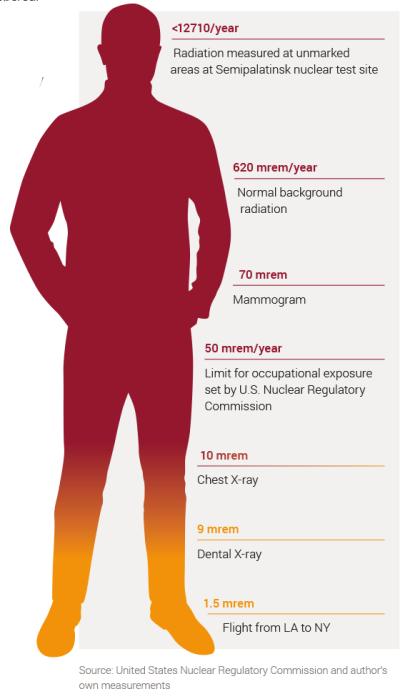
Normal background radiation is between .008-.015 milliRem per hour, and on average we all receive a radiation dose of about 620 milliRem a year. Half of this dose comes from artificial radiation from things like nuclear medicine (x-rays or radiation therapy) and nuclear power plants. The other half comes from natural sources, such as rocks (uranium) and the air (radon). Ionizing radiation has enough energy to damage human genetic material (DNA). In high doses, such as being close to a nuclear accident, exposure can cause radiation sickness. In low-dose exposures there are no immediate health effects, but because doses accumulate, the overall risk of developing cancer, cardiovascular disease or other health problems increases proportionally to the dose received. In 2019, several unmarked areas on theSemipalatinsk Nuclear Test Site that are close to one village in Karaganda province had a Geiger counter reading of .700 milliRem to 1.450 milliRem an hour. This means that those who live there receive an average yearly dose of radiation in two to five weeks.
Lack of monitoring
Because the Institute does not monitor radiation in the villages or in the food people eat, it is unclear whether individuals are receiving excess doses. It is uncertain, for example, whether the higher (more than double) incidences of cancer, cardiovascular diseases, anaemia and mental illness in the region are due to past or present-day radiation exposure, or to other factors, such as alcohol and tobacco use. Furthermore, because the majority of animals raised on the nuclear test site are sold in markets inthe cities of Karaganda, Pavlodar, Semey and the capital, Nur Sultan, people living outside the atomic zone may be unknowingly ingesting radionuclides. It is also unclear whether unprotected radioactive materials can be used to build a radiological dispersal device – or a ‘dirty bomb’ – thus posing a security threat.
Compounding the problem is the fact that the majority of those who live in rural communities in and around the nuclear test site have no knowledge of radiation safety. Moreover, efforts to protect the unmarked radioactive areas and raise awareness about dangerous pollution remain inadequate.
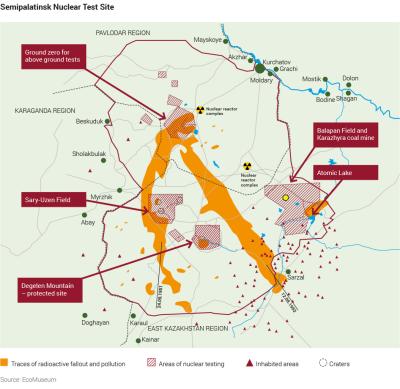
Easy solutions
People living in and around the Semipalatinsk Nuclear Test Site are therefore exposed to residual radioactivity on a day-to-day basis. This is not unique: hundreds of thousands of people, from the Marshall Islands to French Polynesia to the US state of Nevada, experience something similar. But removing people is often not a solution. Dislocation is likely to marginalize an already vulnerable population further.
There are, however, four significant ways in which the Institute, the IAEA and UN organizations can work together to minimize the risks of what is occurring. First, establish education programmes to prevent unintentional exposure to residual radioactivity. Currently, no such programmes exist in the region, though local schools would be well equipped to begin public awareness campaigns on radiation safety. Second, encourage people who are highly respected within local communities—elders, medical personnel, imams to promoteradiation safety programmes. Third, cordon off and secure unmarked radioactive areas on the nuclear test site. Metal signposts should not be used for this, as they would promptly be removed and sold for scrap. Finally, carry out regular radiation monitoring in border villages, as well as of livestock: the Institute is well equipped to lead such a programme.
